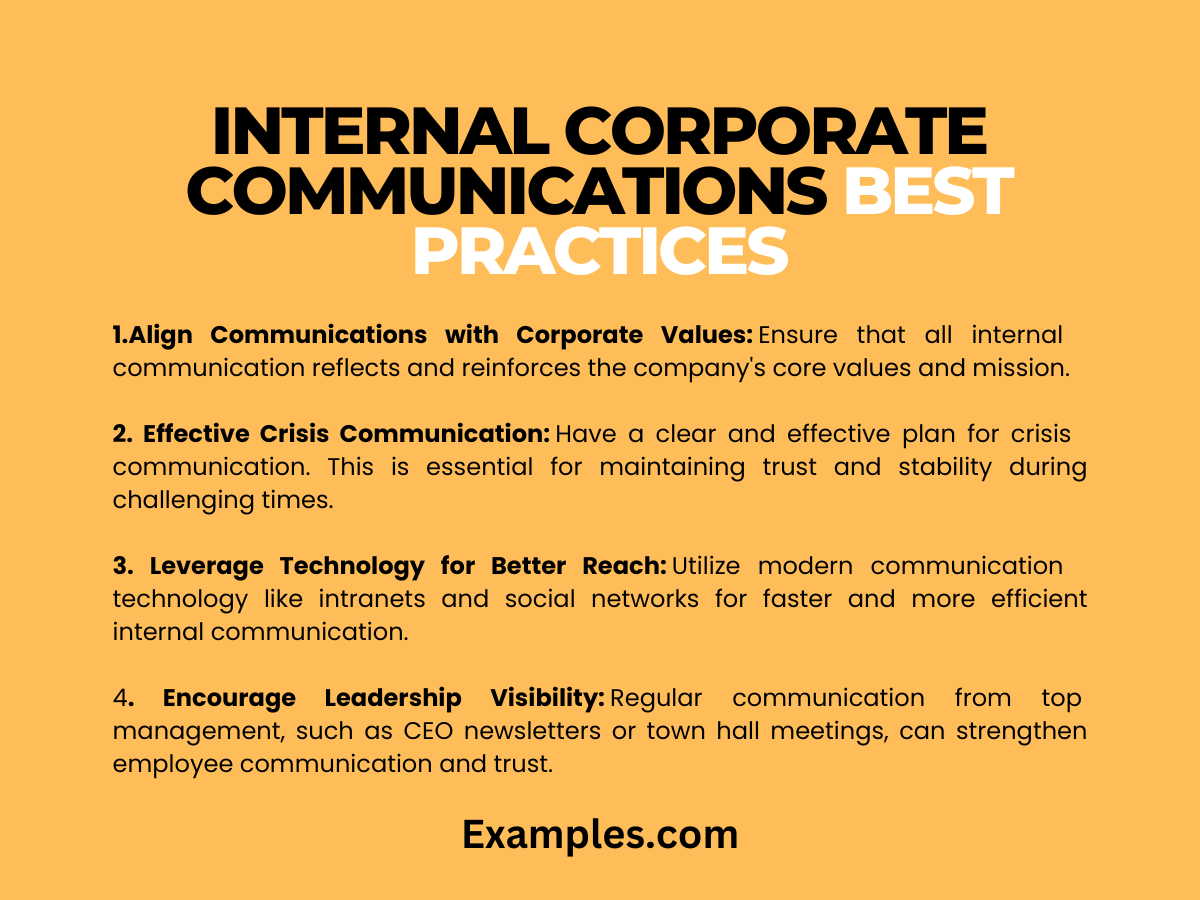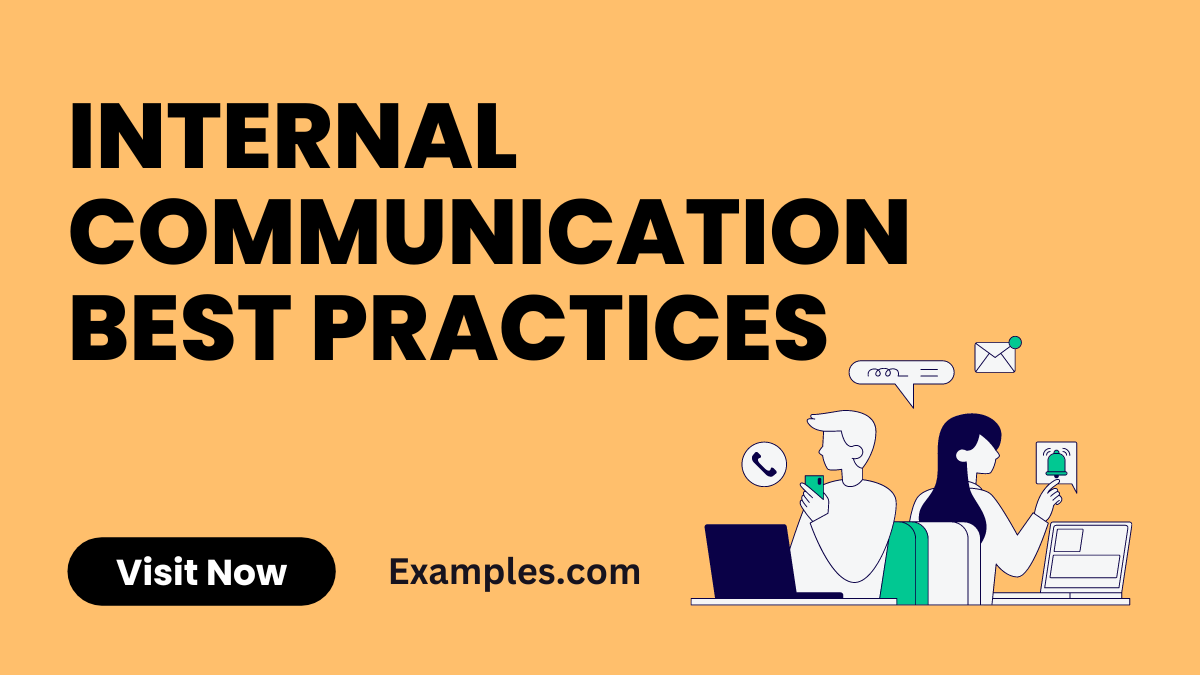14+ Internal Communication Best Practices Examples
In the intricate tapestry of organizational dynamics, internal communication stands as a pivotal thread. This guide delves into the best practices of internal communication, offering a treasure trove of examples that breathe life into abstract concepts. From leveraging digital communication tools to nurturing an environment of open and effective dialogue, this resource is a beacon for those seeking to elevate their internal communication strategies. It’s a comprehensive guide tailored to enhance the internal connective fabric of any organization.
What are the Internal Communication Best Practices?

Internal Communication Best Practices are the strategic approaches and methods used within an organization to facilitate clear, effective, and efficient exchange of information among its members. These practices aim to ensure that all employees are aligned with the organization’s goals, informed about important updates, and engaged in a collaborative, inclusive workplace culture. They encompass a variety of techniques, from digital communication platforms to regular team meetings, all geared towards enhancing internal connectivity and teamwork.
15 Internal Communication Best Practices Examples

- Regular Team Meetings:Facilitate open discussions and updates.
Example: “Let’s have weekly team meetings to discuss progress and address any concerns.” - Internal Newsletters:Keep everyone informed and engaged.
Example: “Our monthly newsletter will highlight team achievements and important updates.” - Employee Feedback Channels:Encourage two-way communication.
Example: “We value your input; please share your feedback through our dedicated portal.” - Transparent Leadership Communication:Build trust and clarity from the top.
Example: “Our CEO will provide monthly company updates to ensure transparency and alignment.” - Cross-Departmental Updates:Promote interdepartmental awareness.
Example: “Join our quarterly cross-departmental meetings to stay informed about company-wide initiatives.” - Digital Communication Platforms:Facilitate easy and efficient online communication.
Example: “Use our Slack channels for daily updates and quick team interactions.” - Recognition and Reward Programs:Acknowledge and celebrate employee achievements.
Example: “Nominate your peers for the monthly ‘Star Performer’ award to recognize their hard work.” - Crisis Communication Plan:Ensure preparedness for unexpected events.
Example: “Refer to our crisis communication guide during emergencies for effective information dissemination.” - Training on Communication Skills:Enhance employees’ communication skills.
Example: “Attend our workshop on effective communication to improve your interpersonal communication abilities.” - Employee Surveys and Polls:Gather insights for continuous improvement.
Example: “Participate in our annual survey to help shape our internal communication strategies.” - Social Media Groups for Employees:Create a platform for informal interactions.
Example: “Join our internal Facebook group to connect with colleagues and share ideas.” - Customized Email Communication:Tailor messages for relevance and impact.
Example: “We will send department-specific emails to ensure you receive relevant information.” - Feedback in Communication:Encourage constructive feedback in interactions.
Example: “Provide your feedback after each meeting to help us improve our communication approach.” - Visual and Infographic Updates:Use visual aids for clear, engaging communication.
Example: “Our infographics in the intranet will summarize key company data and updates.” - Diversity and Inclusion Communications:Foster a culture of inclusivity.
Example: “Our diversity newsletters will feature stories and initiatives promoting an inclusive workplace.”
Internal Communications Strategy Best Practices
In crafting an effective internal communications strategy, it’s essential to prioritize clarity and accessibility. A well-defined strategy ensures that every member of the organization is on the same page, fostering a culture of transparency and engagement.
- Set Clear Communication Goals: Establish specific, measurable objectives for your internal communication. These goals should align with your overall business strategy, enhancing the connection between employees and organizational aims.
- Use a Variety of Communication Channels: Diversify your communication methods to include emails, intranets, and digital communication platforms. This multipronged approach caters to different preferences and ensures wider reach.
- Encourage Two-Way Communication: Facilitate feedback and open dialogue. Tools like surveys and suggestion boxes can make internal communication more interactive, promoting a sense of involvement among employees.
- Regular Updates and Transparency: Keep employees informed about company developments and changes. Transparent communication builds trust and helps in managing rumors and misinformation.
- Tailor Your Messages: Customize your communication to address different departments or teams within the organization. This personalized approach makes the internal communication more relevant and engaging.
Employee Internal Communications Best Practices
When it comes to employee internal communications, the focus should be on building a supportive and collaborative environment. This helps in boosting morale and productivity.
- Recognize and Celebrate Achievements: Regularly acknowledge employee contributions. This recognition can be through company-wide emails, newsletters, or during meetings, enhancing employee communication.
- Provide Training and Development Opportunities: Offer sessions on communication skills and professional growth. This not only improves employee communication but also contributes to their career progression.
- Create a Safe Space for Sharing: Encourage employees to voice their opinions and concerns. This can be through open-door policies or anonymous feedback mechanisms.
- Promote Work-Life Balance: Communicate the importance of a healthy work-life balance. Initiatives like flexible working hours can be communicated through internal communication channels.
- Implement a Mentorship Program: Pairing new or younger employees with experienced mentors can improve employee communication and integration within the company.
Internal Corporate Communications Best Practices

Internal corporate communications play a crucial role in shaping the company’s culture and employee perception. Best practices in this area are key to maintaining a positive and productive work environment.
- Align Communications with Corporate Values: Ensure that all internal communication reflects and reinforces the company’s core values and mission.
- Effective Crisis Communication: Have a clear and effective plan for crisis communication. This is essential for maintaining trust and stability during challenging times.
- Leverage Technology for Better Reach: Utilize modern communication technology like intranets and social networks for faster and more efficient internal communication.
- Encourage Leadership Visibility: Regular communication from top management, such as CEO newsletters or town hall meetings, can strengthen employee communication and trust.
- Measure and Adapt: Regularly assess the effectiveness of your internal communication strategies. Use surveys and feedback tools to gather insights and make necessary adjustments.
In conclusion, this guide on Internal Communication Best Practices serves as a comprehensive roadmap for enhancing workplace communication. By embracing these strategies and tips, organizations can foster a more connected, informed, and productive environment. Effective internal communication is not just a practice but a cornerstone for organizational success, empowering both employees and leaders alike in their collaborative journey.



